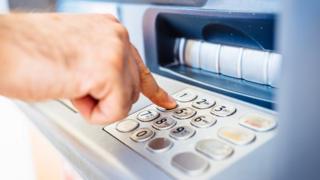 Image copyright
Getty Images
Image copyright
Getty Images
Debate over the future of ATMs in the UK has intensified ahead of a cut in the fee operators receive from banks.
The start of a reduction, over the course of four years, in the fee paid each time a cash machine is used takes effect on Sunday.
Link, which oversees cash machines, has argued that the move is vital for the sustainability of the network.
However, convenience stores, the industry and a consumer group say machines are disappearing.
The fee, known as the interchange rate, will be reduced from 25p to 20p per withdrawal, in annual steps over four years, with a review each year.
However, the fee will be unchanged for free-to-use ATMs which are 1km or more from the next nearest cash machine. Those in remote locations will receive an extra subsidy.
Link has said that the move, alongside other measures, would "shift the incentive" for operators, which have been clustering ATMs in city centres, to move some to rural and less affluent areas and keep the network sustainable as cash use declines.
However, the Association of Convenience Stores (ACS) has calculated that the change could mean a decline in income of between £2,500 and £3,000 a year for some small stores, which were already facing other financial pressures.
The association also argued that stores with cash machines were being disadvantaged, because they were considered as part of their rating for business taxes.
Disagreement
Ron Delnevo, of the ATM Industry Association, suggested that hundreds of the machines had been removed and installations cancelled "at a much faster rate than complacent observers expected".
Consumer group Which? said it had analysed Link figures and suggested that almost 1,500 machines closed between November last year and April, which it said was a near six-fold increase from a steady rate of fewer than 50 closures a month since 2015.
The investigation suggested that machines in rural communities were at least as badly hit as urban areas - down 2.1% and 2% respectively - across the UK at a time when more bank branch closures were being announced.
However, Link disputed the analysis. It said: "Which? has suggested that ATMs have fallen by 1,500 in the period between November 2017 and March 2018, however, Link can confirm that during this period the number of free-to-use ATMs actually increased."